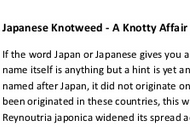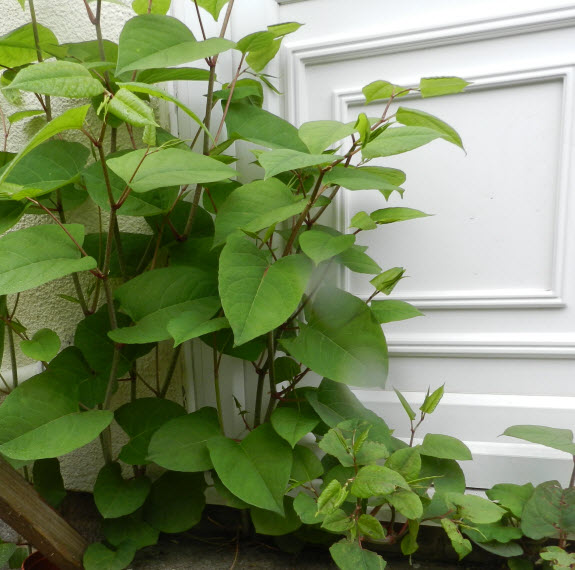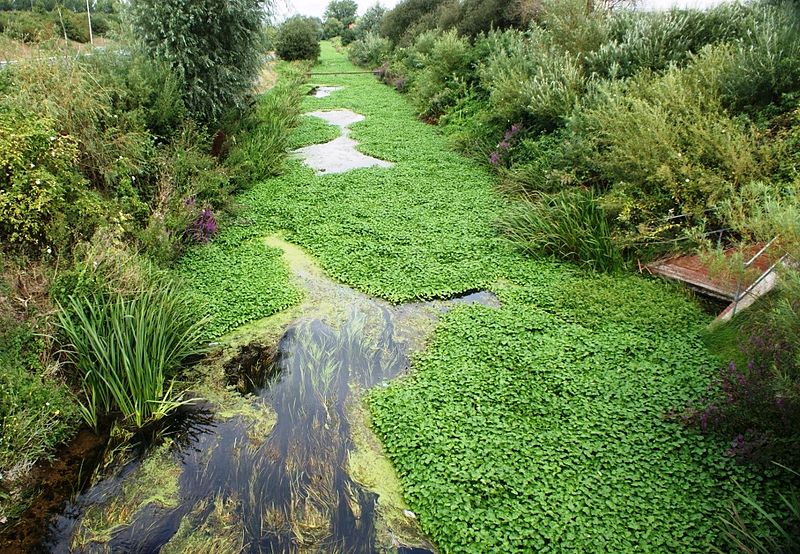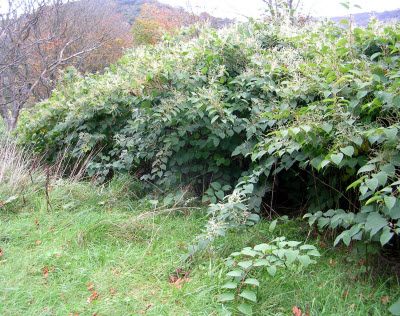This is an informative slideshow and transcript on the succession of Japanese knotweed and its control.
It was produced by James Foster, Lecturer and Head of Geography at Xaverian Sixth Form College in the UK – thanks, James, for this helpful presentation!
- 1. Japanese Knotweed An Example of Succession
- 2. History Japanese knotweed is a perennial pant, introduced from Asia to Europe in the mid-nineteenth century as an ornamental and fodder plant. Grows to a height of 2-3 metres The dead stems and leaf litter decompose very slowly and form a deep organic layer, which prevents native seeds from germinating
- 3. Japanese knotweed thrives on disturbance and has been spread by both natural means and by human activity High water flows disperse fragments of the plant downstream where new colonies form In the past, fly-tipping and transportation of soil containing rhizome fragments have been a major cause of spread, particularly in the urban environment It is only one of two terrestrial plants dealt with by the current version of the UK Wildlife and Countryside Act under which it is illegal to cause it to grow in the wild.
- 4. Typical JK urban invasion Regeneration can take place from the tiniest fragment
- 5. In the UK the species occupies more than half of the 10 km squares used to map plant distribution in the British Isles and is only absent from the Orkney Islands It is a dioecious plant, which means that you need male and female plants for sexual reproduction to occur In Europe so far we only have female plants In total biomass terms, it is probably the biggest female in the world!
- 6. Problems Damage to paving and tarmac areas Damage to flood defence structures Damage to archaeological sites Reduction of biodiversity through out-shading native vegetation Restriction of access to riverbanks for anglers, bank inspection and amenity use Reduction in land values Increased risk of flooding through dead stems washed into river and stream channels Increased risk of soil erosion and bank instability following removal of established stands in riparian areas Accumulation of litter in well established stands Aesthetically displeasing Expensive to treat
- 7. Control Methods (UK) The extensive underground rhizome system sustains the plant even when top growth is removed. Therefore, the aim of any control programme should be to target the rhizomes. Chemicals such as glyphosate are used as they are biodegradable Or herbicides away from watercourses
- 8. For short term control, Japanese knotweed may be cut using a lopper or brush-cutter. In amenity areas, prevention of invasion from adjacent stands may be achieved by frequent mowing The young shoots of Japanese knotweed are palatable to sheep, goats, cattle and horses and grazing may be used in suitable situations to keep the plant under control.
- 9. Warnings Japanese knotweed regenerates vegetatively. Very small fragments of rhizome (as little as 0.7 gram) and fresh stem material are able to produce viable shoots and roots. It is an offence in the UK to cause this plant to grow in the wild under the 1981 Wildlife and Countryside Act
- 10. Cost The British Government’s Non-Native Species Policy Review gives an estimate of the costs to control knotweed countrywide of £1.56 billion Swansea is one of the worst affected areas in the country and as such has the most experience with the costs associated with managing knotweed .
- 11. Using quoted figures of around £1 per square metre for spraying and £8 for landscaping estimates for completely treating the current infestation in Swansea would cost around £9.5 million At the current rate of treatment (2ha/yr) the current infestation will take 50 years to treat without accounting for its rapid spread (more than 2ha/yr) The costs of removal from development sites are very large – One 30mx30m site cost developers an extra £52,785 to deal with the knotweed on the site It is in the building sector where its impact if felt the most. The worst case scenario is a 1m2 patch costing up to £54,000 to eradicate prior to building thanks to normally tight timescales and the need to “dig and dump”.
- 12. Natural (Biological) Control With the increase in trade between countries, many plants and insects arrive in new environments, accidentally or intentionally, without their natural enemies. Due to the lack of pathogens and insects the plant gains an unfair advantage and may become a weed. course it would not be very sensible to introduce insects or pathogens that might attack other plants, especially crops or endangered species
- 13. Frequently Asked Questions
- 14. Why can’t we just leave things as they are? Doing nothing is not an option when it comes to Japanese knotweed as it will continue to spread unchecked across the country
- 15. Isn’t there a danger of releasing another alien species that may become invasive? Whilst the biological control agent may not be native to the UK, it is “native” to knotweed. Only co-evolved natural enemies are considered and these have normally sacrificed their ability to feed on other species to specialise on the target weed.
- 16. Is there an alternative? The only current alternative control method requires the widespread and long-term use of herbicides and since knotweed is still in a rapid expansion phase this could only mean increased chemical use rather than the most stated Government goal of reduced chemical use .
- 17. How can it be that they only attack one plant? Most insects and pathogens are monophagous, that is to say they will only attack one species of plant.
- 18. How can one tiny beetle or fungus do the job? on its own one tiny beetle will not have much effect but once it has reproduced for a few seasons millions of beetles are a force to be reckoned with. Rather than the ephemeral effects of chemicals, the beetles and fungi will continually be debilitating the knotweed and preventing it from competing as strongly Remember the effect of Dutch Elm disease? This was caused by a fungus, carried by a beetle
- 19. What will it eat when it has eaten all of the weed? What normally happens is that there will be considerable fluctuations in the pest and predator populations until an equilibrium is reached which pushes the weed population below the necessary threshold level
- 20. What about the cane toad? The cane toad Bufo marinus, was introduced to Australia by the sugar cane industry in 1935 in an ill-judged attempt to control pest beetles .
- 21. Thousands of toads were released without any host specificity testing and not only failed to control the beetle but turned their carnivorous attention to anything that moved Although carried out in the name of biocontrol, today’s practitioners consider this sorry event to have been an act of madness




